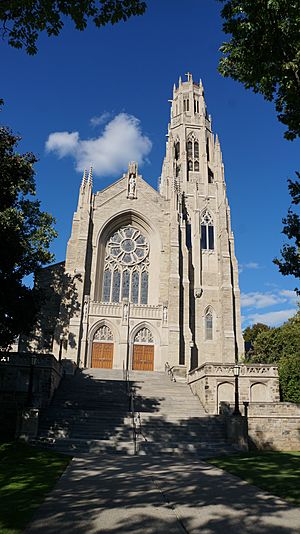Cathedral Basilica of Christ the King facts for kids
Quick facts for kids Cathedral Basilicaof Christ the King |
|
|---|---|

Entrance on the south side
|
|
| 43°15′49″N 79°53′29″W / 43.26348°N 79.89132°W | |
| Location | 714 King Street West Hamilton, Ontario L8P 1C7 |
| Denomination | Roman Catholic |
| History | |
| Former name(s) | Cathedral of Christ the King |
| Status | Cathedral, minor basilica |
| Dedication | Christ the King |
| Administration | |
| Diocese | Hamilton |
| Province | Roman Catholic Archdiocese of Toronto |
The Cathedral Basilica of Christ the King is a large Roman Catholic church in Hamilton, Ontario, Canada. It was officially opened on December 19, 1933. This church is the main church for the Diocese of Hamilton. It is where the bishop of the diocese, Most Rev. Douglas Crosby, has his special chair, called a cathedra.
In February 2013, Pope Benedict XVI gave the cathedral a special title. It became a minor basilica, which is a church with special importance. The cathedral sits on top of a hill, looking over Highway 403. Near the cathedral are the offices for the Hamilton-Wentworth Catholic schools and the Diocese of Hamilton.
On the south side of the bell tower, you can see the cornerstone. This special stone was blessed by Bishop McNally. He was the bishop who had the cathedral built. The stone came from ancient Roman catacombs. This shows the cathedral's connection to the very first Christian churches.
Contents
What Happens at the Cathedral?
Sunday church services, called Masses, are usually led by the church's rector. Sometimes, the bishop or other guest priests will lead them. The cathedral basilica faces south, and its main doors open onto a large stone staircase. This staircase leads down to the front parking lot.
The tall Gothic bell tower is 165 feet high. It has 23 bells and can be seen from far away. The biggest bell is called the Bourdon Bell. It weighs about 4.5 tons! Canada's Prime Minister, R. Bennett, who was a friend of Bishop McNally, donated this bell. At night, bright lights shine on the cathedral. This makes it look very grand, especially from the Hamilton escarpment.
Community Activities
As the main church for the Diocese of Hamilton, the cathedral basilica is a busy place. Many activities for the Roman Catholic community happen here. Different groups meet, like the Knights of Columbus and the Catholic Women's League. There are also groups for children, altar servers, and church ushers.
The cathedral has several choirs that sing during Masses. There is a main Cathedral Choir, a Tenor-Bass Men's choir, and Cantors who lead the singing. The church also has councils to help the rector and team manage the parish.
History of the Cathedral
Bishop McNally became the Bishop of Hamilton in November 1924. He saw that the growing diocese needed a new, impressive cathedral. He chose a great spot that would make the future church look even more amazing. Building such a large church during the Great Depression was a big challenge. Many people protested, but Bishop McNally was determined. He wanted to build "the finest church in Canada."
William Russell Souter, from the company Hutton & Souter, designed the building. He received a special medal from Pope Pius XI in 1933 for his design. The Pigott Construction Company built the cathedral from 1930 to 1933. Joseph Pigott led the project. His family's company also built other famous Hamilton buildings. These include Hamilton City Hall and the Pigott Building.
In 1981, a fire damaged parts of the building. The fire started in the confessionals near a side entrance. The floor, main pulpit, a stained glass window, and the confessionals were all damaged. After the fire, the church had many repairs and updates. A new marble altar was added, and some beautiful woodwork. A stained glass window showing Mary Magdalene was rebuilt to look just like the original design from 1930.
Cathedral Architecture and Design
The inside of the cathedral looks like a 13th-century English Gothic church. Its walls and pillars are made from two types of limestone. These are Indiana limestone and Ontario Credit Valley limestone. The ceiling is vaulted, meaning it has curved arches, and is decorated with gold bosses. This ceiling is a copy of the one in Norwich Cathedral in England.
The cathedral can seat over 1000 people in the main area. Another 200 can sit in the sanctuary area near the altar. There are television screens on the limestone columns so everyone can see. The left side altar has a large painting of Christ entering Jerusalem. It also holds the holy oils in three gold containers. The right side altar has a huge painting of the Nativity Scene. It also has a mosaic showing Our Lady of Perpetual Help.
A large, 88-ton marble structure called a ciborium stands over the tabernacle. It looks like a crown, which is a symbol of royalty. Even though ciboriums are not typical in Gothic churches, this one fits perfectly.
Special Carvings and Windows
The chairs for the priests and the choir stalls have pelicans carved into their armrests. The pelican is an old symbol of self-sacrifice. It represents Christ giving his life for us.
The cathedral has 82 beautiful stained glass windows made by F. Meyer of Munich, Germany. Some windows show stories from the New Testament. Others show many saints high up on the walls. There is a huge rose window at the back, above the organ. It shows the Communion of Saints and Christ the King. Some saints in this window include the Blessed Virgin Mary, St. Peter, and St. Paul. The bottom center panel shows Pope Pius XI and Bishop John McNally.
The main part of the church, called the nave, is 235 feet long. It has two side aisles with large Indiana limestone pillars. The nave is 72 feet wide and 90 feet high. At the back of the church, in the narthex, there is a solid oak statue of Christ the King.
The Grand Organ
The choir loft holds a large pipe organ built in Bavaria, Germany. It has almost 5,000 pipes! Robert Corso is the organist and music director. The organ has different sections of pipes, some in the chancel and some in the gallery. The sound of the organ can be very deep or very bright. In 1981, part of the organ was moved to create more space. In 2016, a new four-manual console was installed. This new console allows the organist to conduct the choirs while playing.
Marble Art and Stations of the Cross
The cathedral also features Italian marble designed in a trompe-l'œil style. This means it creates an optical illusion. The black squares on the floor look like they are coming up, adding depth. This style is used around the tabernacle and on the back of the presidential chairs.
The cathedral also has 14 beautiful Stations of the Cross. These are 3/4 bas relief carvings made in Italy from white Cararra marble. This is the same type of marble Michelangelo used for his famous Pieta sculpture in St. Peter's Basilica in Rome.
Beneath the main church, there is a hall called McNally Hall. It was named after Bishop John Thomas McNally, who built the cathedral. McNally Hall was updated in the early 2000s. The Marian Chapel, used for daily Mass, is also in the basement. There is also a choir rehearsal room, kitchen, and washrooms nearby.
Images for kids
See also
 In Spanish: Catedral basílica de Cristo Rey (Hamilton) para niños
In Spanish: Catedral basílica de Cristo Rey (Hamilton) para niños
- List of churches in the Roman Catholic Diocese of Hamilton, Ontario





